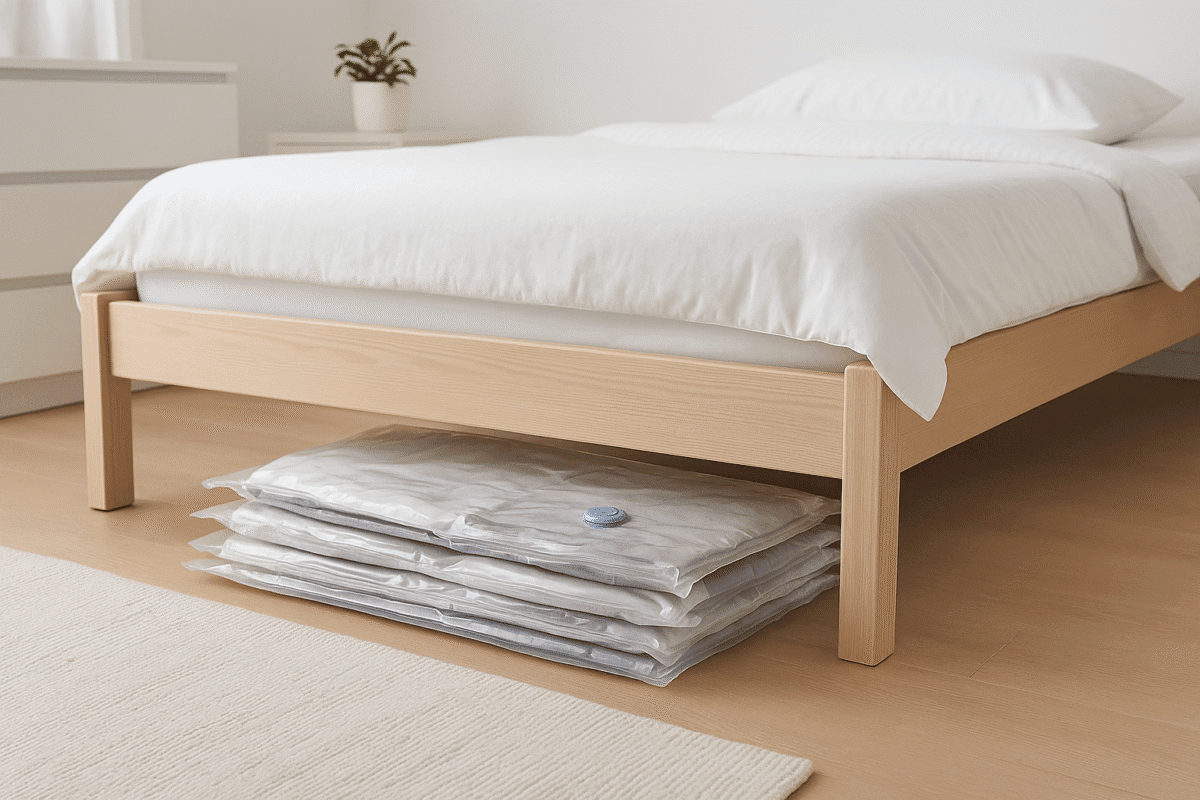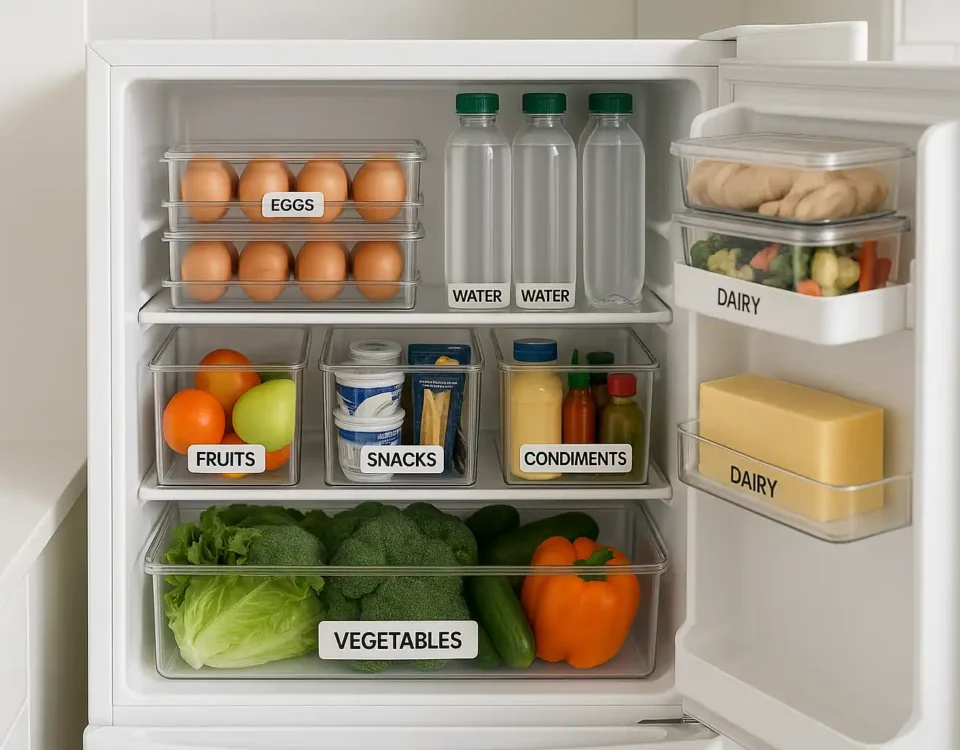
10 Cheap Under Bed Storage Ideas for Small Bedrooms
August 12, 2025
7 Space Saving Nightstand Alternatives for Small Apartments and Urban Renters
August 16, 2025
FTC Disclosure: This post contains affiliate links. If you purchase through them, I may earn a small commission at no additional cost—thank you for supporting our content.
Why Seasonal Storage Feels Overwhelming (and How to Fix It)
If seasonal wardrobe rotations turn your compact bedroom into a clutter disaster, you’re not alone.
- Many renters live in units under 1,000 sq. ft., making closet space precious. For instance, the Census reveals renters often occupy homes around 849 sq ft compared to homeowners’ 1,400 sq ft—highlighting tight living conditions. (Census.gov)
- Meanwhile, textile waste is surging—as noted by the GAO, textile waste in the U.S. has increased over 50% since 2000 due to fast fashion and short-lived clothing trends. (Government Accountability Office)
This isn’t just a storage issue—it’s a space-management, waste-reduction, and lifestyle challenge. In this comprehensive guide, designed for small-space dwellers like urban renters and students, you’ll find:
- A decluttering system rooted in psychology
- 15 space-maximizing strategies (many completely overlooked by most blogs)
- Expert insights and renter success stories
- Science-backed pest and humidity control tips
- A semi-automated wardrobe rotation calendar
- Under-$50 product recommendations with real-world performance
Let’s get practical, professional, and above all—actionable.
If you’re looking for even more ways to free up space beyond seasonal clothing storage, check out our Ultimate Guide to Small Space Organization — it’s packed with creative, renter-friendly solutions you can start using today.
Quick-Start Guide: 3 Steps to Stress-Free Seasonal Storage

If you’re short on time, start here:
- Declutter using the Reverse-Hanger Hack—donate what you haven’t worn in 6 months.
- Protect with breathable bins or vacuum bags, adding cedar blocks or silica gel.
- Rotate using a calendar reminder every April 15 and October 15.
Three steps, one afternoon, and your wardrobe will thank you all year long.
Declutter Intelligently: Mindset Over Stuff
Why Clutter Wins Without the Right Mindset
Even the most ingenious storage won’t work if your wardrobe is bloated. Behavioral psychology tells us letting go is hard—objects feel like extensions of ourselves. According to analysis from Harvard Business Review, parting with possessions registers as loss or pain. That’s why a practical system matters.

Your Simplified System:
- Reverse-Hanger Hack
Hang all clothes backward. After six months, donate items still unchanged. - 10-10-10 Decision Rule
Ask: “Will I wear this in 10 days? 10 weeks? 10 months?” If not—let it go. - Gratitude Goodbye
Mentally thank each discarded item for what it did for you—this reduces emotional friction.
Give Your Clothes a Second Life
Decluttering doesn’t have to mean waste. Here are sustainable ways to part with items you no longer need:
- Donate to local charities, shelters, or thrift shops.
- Upcycle worn-out pieces—turn old shirts into cleaning cloths, pillow covers, or tote bags.
- Swap with friends or neighbors through community clothing swaps.
- Resell on platforms like Poshmark, Depop, or Facebook Marketplace.
Not only will you reduce landfill waste, but you’ll also help someone else enjoy clothes you no longer wear.
Real Story:
Sarah, a nurse in Chicago, used this system and reduced her closet by 40% in three months—without ever feeling overwhelmed or rushed.
The Capsule Wardrobe Advantage

A capsule wardrobe is a small, curated collection—usually 30–40 versatile pieces—that you mix and match throughout the season.
Benefits:
- Fewer clothes to store off-season.
- Easier outfit decisions.
- Higher quality items that last longer.
Example:
A spring capsule might include:
- 5 tops, 3 bottoms, 2 dresses, 2 jackets, 3 shoes, and a few accessories.
Seasonal rotation becomes effortless when you’re only swapping out a handful of key items.
Space-Savvy Storage Solutions for Tight Bedrooms

A. Vacuum Storage Bags – Maximize Bulk Storage
Why it works: Compressed holiday sweaters and blankets pack down up to 70%, freeing under-bed and shelf space.
Tip: Avoid overstuffing—leave a couple of inches to protect fabric structure. Place acid-free tissue inside folds to prevent creases.
B. Under-Bed Storage – Hidden Real Estate

Ideas:
- Low-profile rolling bins—perfect for drawers hidden under beds.
- DIY platforms with casters for heavy seasonal items.
A Tokyo couple stuffed a whole winter wardrobe beneath their full-size bed by installing divided rolling trays—a 40% closet space gain.
Don’t forget about the space under your bed — these 10 Cheap Under-Bed Storage Ideas for Small Bedrooms can turn that unused area into a secret seasonal clothes vault.
C. Over-the-Door & Vertical Organizers

Usage:
- Hang scarves, belts, and scraps via shoe organizers.
- Use pegboards or magnetic panels on walls or inside doors for small-item gear storage.
These instantly reclaim wall space—without drilling, making them ideal for renters.
D. Suitcases & Convertible Gear

Innovative option: Store off-season items in empty luggage—easy to access and excels when storage is tight.
Bonus: Guardrails on clothing racks double as aesthetic display for current-season outfits.
E. Double-Hang Closet Hog

Install a second closet rod using tension or drop-in systems—instant doubling of hanging capacity for shirts and light garments.
F. Drawer Dividers Without Damage
Use inexpensive tension rod dividers to keep folded items separated without screws or tape. Great for organizing undergarments seasonally.
G. Multifunctional Furniture

Storage ottomans, under-the-bed boxes that double as seats—get strategic with multi-use items to reduce clutter and add function.
Defense Mode: Protecting Clothes from Pests & Humidity
A. Pest-Free Naturally
- Cedar blocks and lavender sachets—natural repellents that smell good and deter moths.
- Museum-grade pheromone patches—used by textile conservators, they attract and trap clothes pests in a clean, harmless way.
B. Humidity Management
Books on textile conservation recommend 45–55% relative humidity for optimal fabric preservation.
Budget hack: rechargeable silica gel or rock salt packs in breathable cotton bags to soak moisture.
Pro tip: smart humidity sensors (priced around $25) can send alerts via phone when levels shift.
Safety First in Seasonal Storage
If you have pets or young children, storage safety matters just as much as organization:
- Avoid mothballs or chemical repellents—they can be toxic. Opt for cedar or lavender instead.
- Store heavy bins on lower shelves to prevent falls.
- Use lockable storage boxes for items that could be hazardous or easily damaged.
A safe storage system protects both your wardrobe and your household.
Adapting Storage to Your Climate

Seasonal storage isn’t one-size-fits-all—your local climate plays a big role in what works best.
- Humid climates (e.g., coastal areas) – Mold and mildew thrive in damp air. Use breathable cotton bags instead of plastic, add silica gel packs, and ensure stored items are fully dry before sealing.
- Dry climates (e.g., desert regions) – Fabrics can become brittle and lose color faster. Keep clothes away from direct sunlight, add a small humidifier in storage spaces, and store delicate items in acid-free tissue.
- Cold climates – Sudden temperature changes can cause condensation and damage fibers. Let clothes adjust to room temperature before unpacking after long storage.
By tailoring your approach, you’ll prevent damage that one-size-fits-all tips can’t solve.
When Storage Lasts More Than a Season
If your clothes stay packed away for more than a year, certain risks increase:
- Elastic breakdown in waistbands and cuffs.
- Color fading from light leaks or poor wrapping.
- Fiber weakening in delicate materials like silk or linen.
Prevention tips:
- Store in dark, temperature-stable spaces.
- Wrap delicate fabrics in acid-free paper.
- Air out and refold garments every 8–12 months to prevent permanent creasing.
Think of it as a “checkup” for your wardrobe—just like any other valuable investment.
Simplify Your Seasonal Rotation with a 6-Month Blueprint
| Season | Date | Key Tasks |
|---|---|---|
| Spring/Summer | April 15 | Launder winter items with safe detergent → Silk-safe fold → Store in breathable bags with cedar disks |
| Fall/Winter | October 15 | Sun-dry summer clothes → Fold using minimalist methods → Add silica packets between layers |
Set Google Calendar reminders with these tasks and attached checklists for seamless execution.
Product Performance Table
| Product | Price | Best For | Key Advantage | Consideration |
|---|---|---|---|---|
| Canvas Storage Bin (30L) | $29 | Sweaters, Silk items | Breathable + stackable | Needs 6-in clearance under bed |
| Vacuum Space Bags (6-pack) | $18 | Bulky coats, Linen | Massive volume reduction | Needs vacuum or pump during storage |
| Compact Wardrobe Rack | $40 | No closet spaces | Adjustable and mobile | Limited load capacity |
Reader Stories: Real Transformations
- Mark, San Francisco (85-sq-ft room): “A vertical pegboard system gave me room for four seasons in a space smaller than most walk-ins.”
- Priya, London (no closet): “I hung a tension rod in a window alcove—curtained it—and created a beautiful seasonal capsule wardrobe display.”
8. Your Seasonal Storage Checklist
- Set up donor box and start daily triage
- Buy vacuum bags, breathable bins, or organizer tools before next rotation
- Place cedar or silica in all bins
- Mark rotation dates in your calendar
- Run an inspection every quarter
FAQs
Q: Can I store clothes without damaging them in vacuum bags?
A: Yes—if you leave space and layer delicate items with tissue. Avoid use for silk, as airtight compression can damage structure.
Q: What’s the fastest way to reduce wardrobe clutter?
A: The reverse-hanger trick and 10-10-10 decision rule help drop items you don’t need without hesitation.
Q: How often should I check on stored items?
A: Inspect the storage every 60–90 days for pests or mold. Full seasonal rotations executed every six months help maintain order.
✍️ Written by: Jamie Lewis, Certified Home Organization Specialist & Interior Designer
15+ years designing efficient small spaces in NYC & Tokyo
Field-Tested by: Our small-space living team (400–600 sq ft homes)
6-month trials • Before/after results • Budget-friendly scenarios
💡 Affiliate Disclosure: This article may contain affiliate links. We may earn a small commission — at no extra cost to you — if you make a purchase through our recommendations. We only feature products we believe will genuinely improve small-space living. Learn how we stay impartial.
Published by Mehran Azam • Smart Space Tips • Last updated:

